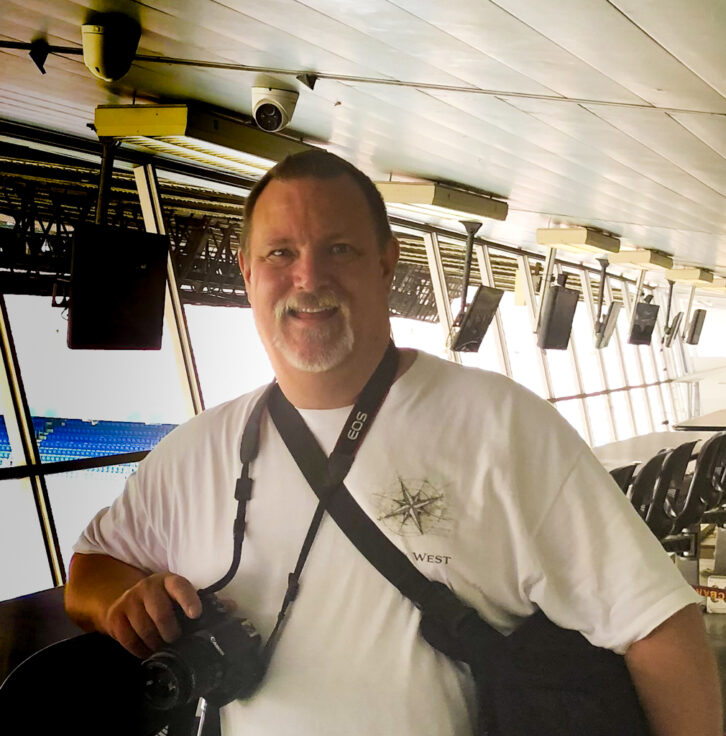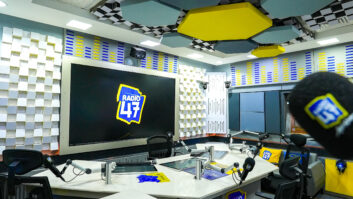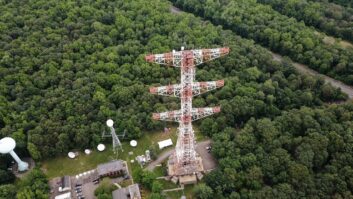When Mike Kernen came to Crawford Broadcasting as its Detroit market chief engineer in April 2020, he brought with him 32 years of experience, having supervised engineering at Greater Media’s Motor City properties and then serving Beasley Media for four years after it acquired the cluster.
Crawford’s market stations brought a unique challenge. In addition to stalwart WMUZ-FM on 103.5, Crawford owns three AM stations in the region, all running directional arrays, most notably 1200 WMUZ(AM), “The Salt of Detroit.” Licensed to Taylor, it has a complex directional antenna system for its nighttime pattern.
“I was nervous about taking on the 10-tower array,” Kernen said. “I knew the theory behind AM broadcasting and had some experience maintaining (AM 760) WJR. But just the complexity with the setup, at first, was intimidating.” Kernen credits Cris Alexander, Crawford’s director of engineering and Radio World contributor, with giving him the tools he needed to succeed.
“Cris showed faith in me that I could be an AM guy,” Kernen said. “I’ve come to love it; it’s the most exhilarating part of my job given its intricacies.”
At Crawford’s Detroit-area properties, Kernen oversees everything technical, from ensuring that the grass at the transmitter and antenna sites is well-maintained, to managing its computer networking.
Troubleshooting

WMUZ’s AM antenna array is located about 19 miles southwest of the center of Detroit in Huron Charter Township, nestled in a field between greenhouses and a couple of churches, in landscape that is quintessential outlying lower Michigan.
The station signed on in 1990 as 25 kW day and 1 kW night. A frequency change by a co-channel station in Frankenmuth, Mich., a few years later made 50 kW day possible, and with the addition of more towers to narrow the directional pattern, 15 kW night was authorized as well in 1993.
Crawford acquired the station from Radio One in 2017. The station was silent for several months that year, and its antenna site needed some upgrades.
“The site was in remarkably good shape overall,” Alexander said. “The biggest change we made out of the gate was replacing the main transmitter with a new Nautel NX50. That allowed us to operate the station more efficiently and in the hybrid MA1 digital mode.”
“It has been terrific, it works like a hose,” Kernen said of the NX50. WMUZ(AM) also has a 5 kW GatesAir transmitter for auxiliary purposes.
The next order of business was troubleshooting the AM’s automatic switching from its 10-tower, 15.8 kW nighttime pattern to its four-tower, 50 kW daytime pattern.
Intermittently, Kernen would receive alerts at sunrise that at least one of the 10 Kintronic Labs custom-made antenna tuning units had failed to switch, leading to an inability to transition to the daytime pattern. Consequently, the station would be off the air.
The intermittent nature of the failures, and the variety of components subject to failure, led to a Whac-a-Mole process of troubleshooting.
“You would make a change, see a response and the next thing you knew, the same issue would occur,” Kernen said. He replaced microswitches within the ATUs, changed coils on contactors and identified bad coil within the site’s phasor, which Kernen said is the size of a small bus. Yet the issue persisted.
Kernen decided to measure the voltage coming back from the ATU with a multimeter. He found that the relay inside Tower 10’s ATU was receiving only 16.7 volts, indicating that over 9 volts were being lost across the loop of wire going to tower 10 and coming back to the controller.
“There’s no way the length of the cable would be responsible for that great of a voltage drop,” Kernen said. The ultimate culprit? A wire inside the transmitter building wasn’t seated properly. Opening the screw on the terminal block and retightening the wire fixed the issue entirely.
“A valuable takeaway from this experience,” Kernen said, “is that often, we can get caught up in the complexities and, based on our past experiences, overthink issues. Sometimes the answer lies in simplicity. It’s important to be aware of our tendencies and occasionally approach problems from a counterintuitive angle.”
Alexander agreed and noted some common patterns savvy engineers like Kernen pick up on. “Other than the size of the components, AM antenna systems use the same basic blocks of LC circuits you would find in any RF device,” he said.
Freshened up

Alexander has composed several documents that he shares with engineers during the on-boarding process. “I wrote a white paper years ago on dealing with problems in AM directional antenna systems,” he said. “In that document, Rule Number One is don’t try to fix antenna problems with phasor controls! Find the underlying cause and deal with it.”
Kernen is proud of the progress he and the team at Crawford have made at WMUZ, and the work has continued. Following his recommendations, a new storage building was constructed 50 feet from the transmitter building, for tractors and other equipment. New security cameras were installed at the site, along with interior and exterior illumination for the new structure.
A new roof was installed on the transmitter building this year, followed by a repaint. New gravel was paved on the road to the site, and the west doors to the building were replaced; the previous ones had rusted due to the strong westerly wind that often blows in from the field.
“For me, it’s a thrill, to go from a station left to go dark, to a site that we are proud of,” Kernen said, adding that he regularly receives QSL reports on 1200’s nighttime signal from as far away as Finland.
There are, of course, other challenges that any engineers with complex sites in semi-rural settings can attest. WMUZ’s antenna site is in a very low area built on a former landfill and thus is prone to standing water, which means water intrusions can be frequent.
“A contractor comes in once a month to deal with mice, wasps, bees and mosquitos during the warm season,” Kernen said, recalling a particularly challenging day last August when he was stung four times by bees.
“Nowadays, managing the 10-tower array is less challenging than overseeing the other two AM sites,” Kernen said. The transmitter site of WCHB 1340 in Royal Oak, Mich., took in an inch of water during one weather event; this was corrected with the installation of a whole new drainage system. The third Crawford AM in lower Michigan, 560 WRDT Monroe, broadcasts from separate sites for its daytime and nighttime patterns, and it has a separate 107.1 FM Detroit translator as well, all of which keeps Kernen often on the go.
Kernen appreciates Crawford’s support for AM and expresses pleasure in his daily role.
“The saying is true, if you love what you do, you never work a day in your life,” Kernen said. “It’s a profound feeling, knowing that what you’ve worked on reaches millions. It’s truly inspiring.”







